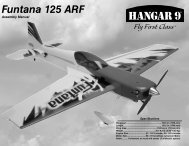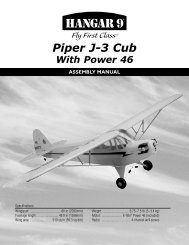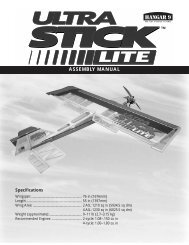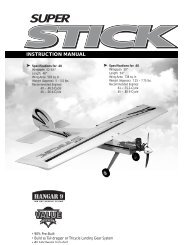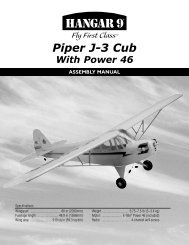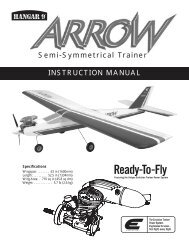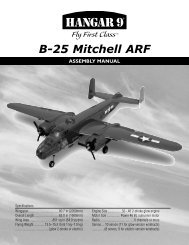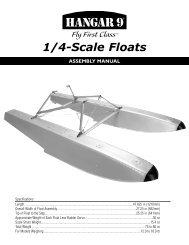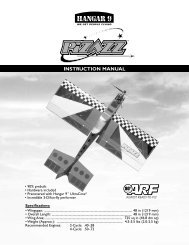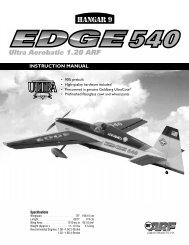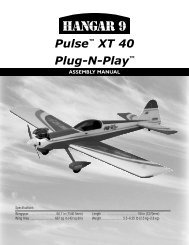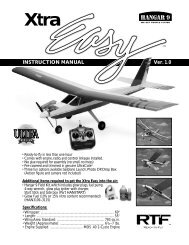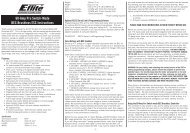instruction manual - Hangar 9
instruction manual - Hangar 9
instruction manual - Hangar 9
You also want an ePaper? Increase the reach of your titles
YUMPU automatically turns print PDFs into web optimized ePapers that Google loves.
Glossary<br />
Adverse Yaw. Some airplanes, especially high-wing airplanes<br />
with flat-bottom airfoils, have a tendency to yaw in the opposite<br />
direction of the bank. This is most common when flying at low<br />
speeds with high angles. Adjusting the ailerons can help reduce<br />
the yaw.<br />
Ailerons. Each side of this airplane has a hinged control<br />
surface, called an aileron, located on the trailing edge of the<br />
wing. Move the left aileron up and the right aileron down, and<br />
the airplane will turn or roll to the right. Perform the opposite<br />
actions, and the airplane will roll to the left. This is how you<br />
control the airplane's direction in flight.<br />
Carburetor. By adjusting the needle valve in the carburetor,<br />
you control the engine’s lean/rich fuel mixture and determine the<br />
airplane's speed.<br />
Charger. This is the device used to charge/recharge batteries.<br />
If NiCad batteries are provided with the radio, a charger is<br />
usually provided as well.<br />
Clevis. The clevis connects the wire end of the pushrod to the<br />
control horn of the control surface. A small clip, the clevis has<br />
fine threads so that you can adjust the length of the pushrod.<br />
Clunk. Located in the fuel tank, a clunk is weighted and<br />
ensures that the intake line has a steady supply of fuel.<br />
Computer Radio. By using the advanced programming<br />
functions of the transmitter, you can adjust the airplane without<br />
changing any mechanical structures.<br />
Control Horn. This arm connects the control surface to the<br />
clevis and pushrod.<br />
Dead Stick. When the airplane is in flight gliding, without the<br />
engine running, it is called “dead stick.”<br />
Dihedral. The degree of angle (V-shaped bend) at which the<br />
wings intersect the plane is called dihedral. More dihedral gives<br />
an airplane more aerodynamic stability. Some sailplanes and<br />
trainer planes with large dihedral dispense with ailerons and use<br />
only the rudder to control the roll and yaw.<br />
Electric Starter. This is the small motor commonly used to<br />
start the airplane's engine.<br />
Elevator. The hinged control surface functions as an elevator,<br />
which you adjust to control the airplane's pitch axis. Pulling the<br />
transmitter's control stick toward the bottom of the transmitter<br />
adjusts the elevator upward, and the airplane begins to climb.<br />
Push the control stick forward, and the airplane begins to dive.<br />
Expanded Scale Voltmeter (ESV). This device is used to<br />
check the voltage of the battery pack.<br />
Flight Box. The box in which you store and transport your<br />
flying equipment is called a flight box.<br />
Flight Pack or Airborne Pack. These interchangeable terms<br />
describe the radio equipment that is installed on the airplane.<br />
Foam Rubber. Material that is used to dampen the airplane's<br />
vibrations and protect the airplane's battery and receiver.<br />
Fuel Overflow Line (Vent). This line pressures the fuel tank<br />
and provides an even fuel flow to the engine. It also functions<br />
as an overflow line when the fuel tank is full.<br />
Fuel Pickup Line. This line connects the fuel tank to the<br />
carburetor, usually with a clunk on the tank end to keep the fuel<br />
flowing while the aircraft is in flight.<br />
Fuselage. The main body of an airplane.<br />
Glow Plug Clip/Battery. A 1.2-volt battery with a clip which<br />
is connected to your engine’s glow plug used to start the engine.<br />
You remove it once the engine is running smoothly.<br />
High Wing. This term describes an airplane that has its wings<br />
mounted on the top of the fuselage.<br />
Hinge. The hinges are the moving blades on the control<br />
surface that allow you to control the airplane's movement. All<br />
hinges must be glued properly and securely to prevent the<br />
airplane from crashing.<br />
Horizontal Stabilizer. The horizontal surface of the tail gives<br />
the airplane stability while in flight.<br />
Main Landing Gear. The wheel and gear assembly the<br />
airplane uses to land. It is attached to the bottom of the<br />
fuselage.<br />
Muffler. This device muffles engine noise and increases the<br />
back pressure from the engine’s exhaust stack, which can<br />
improve the airplane's performance at low speeds. Mufflers are<br />
usually required by R/C Clubs.<br />
Needle Valve. This mechanism within the carburetor adjusts<br />
the fuel mixture and throttle. Refer to your engine’s<br />
manufacturer <strong>instruction</strong>s for directions on how to adjust the<br />
needle valve.<br />
45



